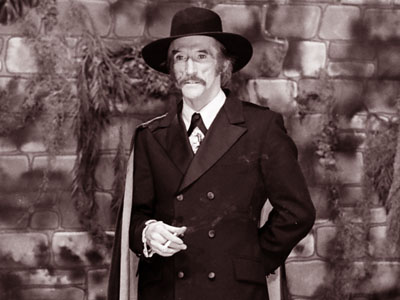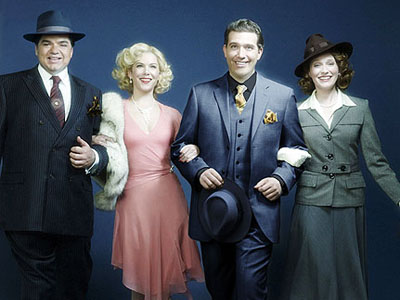It's always seemed to me a bulletproof show, in part because of its simplicity. There aren't a lot of choices possible to some aspects of it. One production of Guys and Dolls tends to resemble all other productions of Guys and Dolls in a way that is not true of most oft-mounted shows. So I've been intrigued about this one that reportedly did a lot of unconventional things…and closed a lot faster than revivals of Guys and Dolls usually close. What, I wondered, went wrong?
Well, like I said, I didn't see it. But my pal Bob Ingersoll did and he filed this report…
The show got off on the wrong foot immediately. Guys and Dolls, which is how I will, hereinafter, refer to the original version and every version of the show I've seen until the revival I'm analyzing, opens with a pantomime ballet played out over the overture called Runyonland. In Guys and Dolls, Runyonland is a fairy tale representation of seedy side of Times Square in a kind of timeless time that's supposed to represent Broadway during Prohibition and the Depression, but isn't quite. (After all, the title song has a line about someone watching a "television set.") Runyonland is populated by grifters, pickpockets, gamblers, and other small-time crooks and conmen. In the production I was in where I played Hymie Banjo Eyes (our director gave everyone, even chorus members, actual names pulled from actual characters of Damon Runyon stories and because of my bright blue eyes, I became Hymie Banjo Eyes) my Runyonland con was to pretend to be a photographer who would take pictures of tourists and collect money from them with the promise that I would send them their pictures as soon as I developed them. I, of course, discarded their contact information on stage as soon as they weren't looking.
In other words, Runyonland is seedy but not really dangerous. Yes, Sky Masterson is quick with his fists, but he's not violent. The only character who is supposed to represent any real danger of real violence is Big Jule, a Chicago gangster who is in town to participate in Nathan Detroit's floating crap game. At one point in Guys and Dolls, he even tries to pull out a gun. But Sky Masterson dispatches Big Jule with one punch and does so with such speed that even the East Cicero, Illinois gangster isn't truly a menace.
The revival, which is how I will, hereinafter, refer to the version of the show that I saw this year, starts with Damon Runyon, himself, sitting at a typewriter banging out a the start of a story and then crumpling it in disgust. Runyon then goes out into the city and wanders around it observing. This wandering is played out in the revival's version of Runyonland.
We are, of course, to believe that what he sees inspires the stories for which he will be known later, as we are shown at the end of the revival, when Runyon is shown writing a story and quite happy with the result. The trouble is, what Runyon sees isn't the kind of idealized, fairy tale seedy New York that he would write about, and which was incorporated into Guys and Dolls. He sees a tougher world with hints of actual violence. One of the cons he observes, for example, involves a poker game in which one player accuses another of cheating. They get into a fight and one of the players shoots another of the players. All of the other players then scatter, leaving their money in the middle of table. Then the "dead" player gets up and splits the money with the player who "shot him."
Okay, there wasn't any actual violence, but the hint of a more violent world than Guys and Dolls ever showed definitely exists. And it sets the wrong tone for the show.
This more-violent world is shown even more dramatically later, in the scene when Nathan Detroit is talking with Joey Biltmore about using his garage for the crap game. While the conversation goes on, Biltmore also supervises two of his henchmen, who take a bound-and-gagged man, put him in the trunk of a car, and drive it away.
That, of course, means that this poor man is about to be "hit," killed. This is more than a suggestion of violence. It is real and true, life-and-death violence. Oh, the violence may not happen on-stage, but everyone knows what's going to happen. That sequence makes it impossible to believe that Runyonland is set in the charmingly seedy but non-threatening New York that Runyon wrote about or which Guys and Dolls needs in order for its characters to be likable.
Second problem with the revival is the dialog. Runyon wrote a very specific kind of dialog. A combination of formal speech and slang, always spoken in the present tense. Here's an example from Tobias the Terrible in the story "More than Somewhat," an example which was nicely copied onto Wikipedia, so that I could cut-and-paste it here easily. "If I have all the tears that are shed on Broadway by guys in love, I will have enough salt water to start an opposition ocean to the Atlantic and Pacific, with enough left over to run the Great Salt Lake out of business. But I wish to say I never shed any of these tears personally, because I am never in love, and furthermore, barring a bad break, I never expect to be in love, for the way I look at it love is strictly the old phedinkus, and I tell the little guy as much."
Such dialog requires a certain cadence. If spoken with the proper cadence, Runyon's dialog is bright and distinctive. When it's not spoken with the proper cadence, Runyon's dialog sounds strange and stilted. The revival was full of people who sounded like they were trying to speak with the Runyon cadence rather than actually speaking with it. They were trying too hard to speak Runyonese properly. As a result, the dialog never sounded proper. It sounded forced.
This was nowhere more apparent than with Oliver Platt, who played Nathan Detroit. He never really captured the Runyon cadence and, as a result, almost everything that came out of his mouth sounded painful.
The other problem with Platt is that he was literally and physically big for the role of Nathan Detroit. Detroit is a little man, one who is physically intimidated by the imposing size and bulk of Big Jule.
Oliver Platt is 6' 3½"
Platt was actually taller than Kearran Giovanni, the actor who played Big Jule. The whole dynamic of Nathan's character never worked with the very tall Platt in the role. It worked when in the movie where 5'7" Frank Sinatra played Nathan Detroit or on Broadway when the even shorter 5'5" Nathan Lane played Detroit.
That's, anyway, where I think the revival failed. The way it handled the setting of Runyonland didn't work. The way the actors delivered Runyonese didn't work. Oliver Platt and Nathan Detroit didn't work on any level. All of those things made it difficult for me to buy into the concept that I was in Runyonland as opposed to seeing a bunch of people trying to make me believe I was in Runyonland. As a result, the show never pulled me in. I felt distant and detached from it and, ultimately, dissatisfied. I suspect other people who watched the show felt the same. And I suspect their detached dissatisfaction was communicated to others, either in reviews or by word-of-mouth. So, as a result, people didn't go to the show, because who wants to spend the hundreds of dollars a night out on Broadway costs nowadays to be dissatisfied?
I saw Nathan Lane in the role and he was quite wonderful. So was that entire production, especially Faith Prince as Miss Adelaide. I suspect from afar that it hasn't been long enough since that version to mount a new Guys and Dolls unless you're going to do something quite different with it…and if you do something quite different with it, it ain't Guys and Dolls. A lot of old shows can stand some rethinking but this one is just too familiar. Everyone knows where it's going and how to get there so deviations are distracting.
The only really awful production I ever saw was a 1980 touring company in which Milton Berle played Nathan Detroit and did everything in his power to turn the evening into The Milton Berle Show. Mr. Detroit has but one song in Guys and Dolls — the result of that role having been originated by the non-singing Sam Levene. When Sinatra played the role in the movie, they added a couple of new tunes for him — not very good ones — and stuck him in the "Guys and Dolls" number even though its theme is completely contrary to Nathan Detroit's attitude at that point in the story. Berle didn't get the extra songs but his Nathan not only sang in "Guys and Dolls" but darn near turned it into a solo.
It was that way the whole evening. Sounds like what you saw could challenge it in the category of Getting It Wrong.


